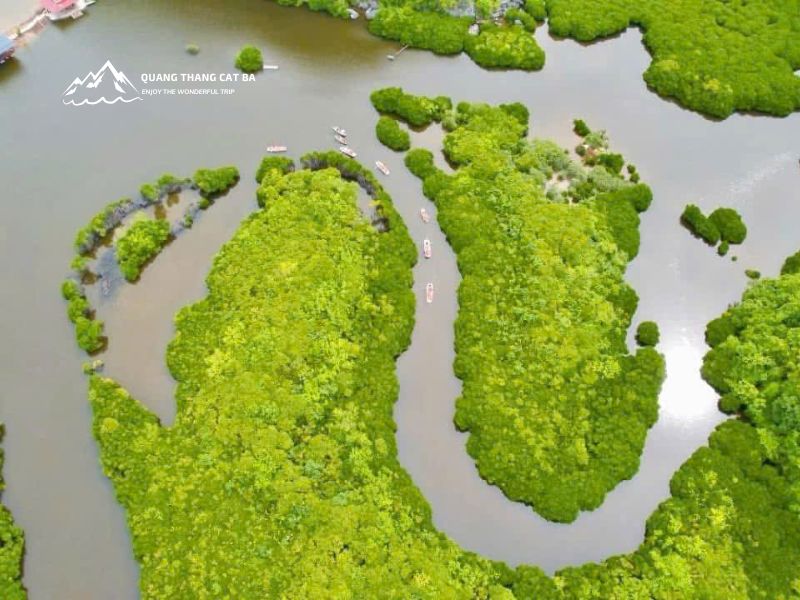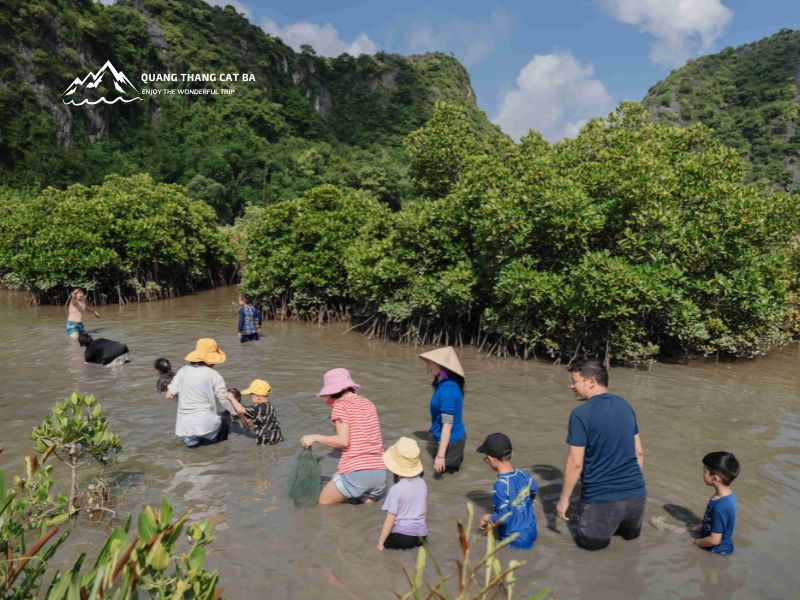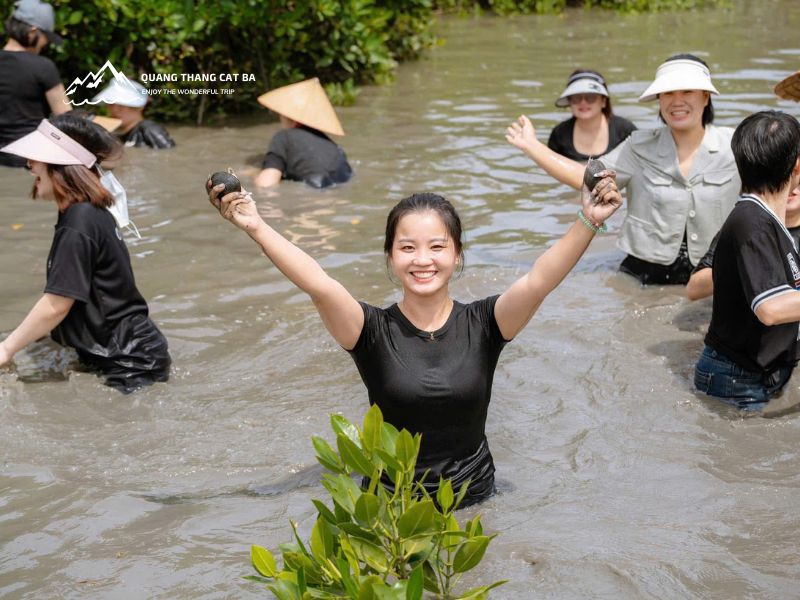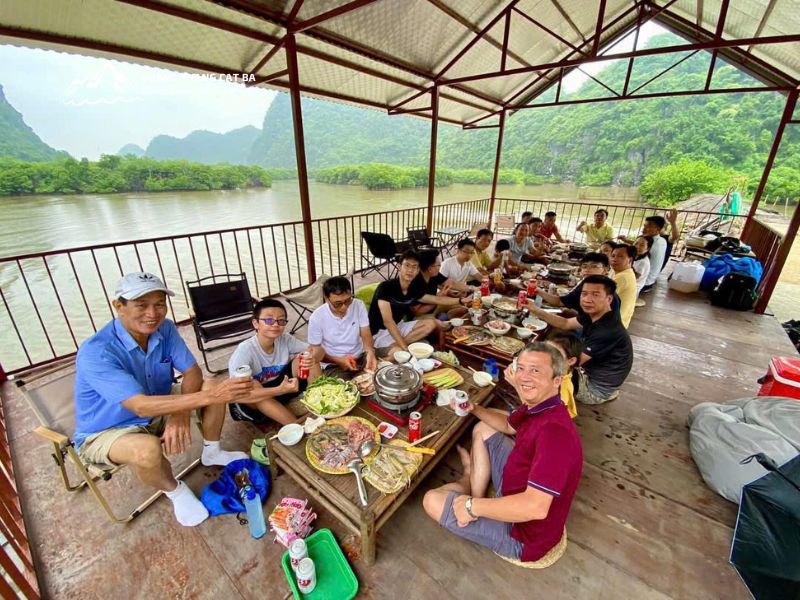Step into Phu Long Mangrove Forest, Cat Ba’s tranquil green heart, where mirror-calm canals, bird calls, and tangled mangrove roots create a living watercolor. I’ll guide you through narrow waterways, local shell-gathering, and the secret Phu Long Cave—timed to the tides for comfort and safety. Expect soft light, fresh breezes, and unforgettable photos on a gentle, eco-friendly journey.

What Is Phu Long Mangrove Forest & Why It’s Worth Exploring
If you’ve ever dreamed of wandering into a place where nature remains untouched — where gentle waves ripple beneath the shade of mangrove trees — then Phu Long Mangrove Forest is your ideal destination.
Located in Phu Long Commune, Cat Hai District (now in Cat Hai Speacial Zone) – the northern gateway to Cat Ba Island, this vast mangrove forest isn’t just a scenic spot; it’s the green heart that sustains the island’s entire ecosystem.
Here, nature feels alive. When the tide rises, the water glides softly over the roots of mangroves, turning the landscape into a shimmering watercolor painting. As the tide retreats, the interwoven roots of mangrove, Avicennia, Sonneratia, and Bruguiera trees emerge — like the living veins of the earth, creating a mesmerizing ecological picture unlike anywhere else in northern Vietnam.
Location of Phu Long – The Northern Gateway to Cat Ba Island
Phu Long lies at the entrance of Cat Ba Island — the first place you’ll reach if you travel by Got – Cai Vieng ferry or the modern Cat Hai – Phu Long cable car.
From Cat Ba town center, it takes only about 25 minutes by taxi or motorbike to reach the edge of the forest.
This unique area sits at the intersection of saltwater and freshwater, between island and mainland — forming a rare and delicate ecosystem.
Standing on the Phu Long pier, you’ll see endless green stretching to the horizon, with small bamboo boats gliding through the calm water. The sound of paddles, the scent of brackish air, and the stillness of the landscape make it a perfect escape for anyone seeking tranquility.
Scale & Key Features (Covering Nearly 700 ha)
Covering nearly 700 hectares, Phu Long Mangrove Forest is the largest mangrove ecosystem on Cat Ba Island and a vital part of the Cat Ba World Biosphere Reserve, recognized by UNESCO in 2004.
This vibrant ecosystem is home to classic mangrove species such as Sonneratia, Avicennia, Bruguiera, Rhizophora, and Nypa palm, as well as countless aquatic species — from small crabs and fish to herons and migratory birds.
|
Feature |
Description |
|
Area |
~700 hectares – the largest on Cat Ba Island |
|
Location |
Phu Long Commune, Northern Gateway of Cat Ba |
|
Typical Flora |
Mangrove, Avicennia, Sonneratia, Bruguiera, Nypa Palm |
|
Representative Fauna |
Crabs, small fish, shellfish, waterbirds |
|
Ecological Role |
Soil retention, water filtration, climate regulation, coastal protection |
|
UNESCO Recognition |
Part of Cat Ba Biosphere Reserve (2004) |
The intricate mangrove roots form a natural seawall, protecting the coastline from erosion and strong waves.
At the same time, the dense vegetation acts as a living filter, purifying water, improving air quality, and balancing the island’s microclimate.
And when you take a small boat into the heart of the forest, the rhythmic sound of paddles against calm water reminds you — you’re not just sightseeing, you’re witnessing nature’s pulse in motion.
Its Role in Cat Ba’s UNESCO Biosphere Reserve & Coastal Environment
Within the Cat Ba Biosphere Reserve, Phu Long Mangrove Forest plays a crucial role in preserving biodiversity and maintaining the coastal ecological balance.
It serves as a breeding and nursery ground for various marine species, a refuge for migratory birds, and a protective shield for coastal villages during storms and high tides.
Moreover, it represents an essential link between Cat Ba’s limestone forests, marine ecosystems, and tidal wetlands, forming one of Vietnam’s most complete and diverse natural environments.
For travelers and researchers alike, Phu Long is not just a destination — it’s a living classroom, a symbol of harmony between nature and people, and a reminder of how fragile yet resilient our planet truly is.
What You’ll See & Feel When Entering the Forest
If you’ve ever wondered what Cat Ba’s untouched nature truly feels like, Phu Long Mangrove Forest will give you the most vivid answer.
As your small wooden boat gently glides into the forest, the world around you becomes still — replaced by the rhythmic splash of paddles and the whisper of the wind through mangrove leaves. The air is cool and fresh, carrying the faint scent of brackish water and young mud — the pure aroma of life where the sea and earth embrace.

Mangrove Roots – The Living Map Beneath Your Feet
The first thing that catches every visitor’s attention is the maze of mangrove roots twisting beneath the water’s surface. These intricate roots, stretching like veins through the soft mud, hold the soil, store nutrients, and protect the land from the strong coastal tides.
Look closer, and you’ll realize each root forms part of a living natural map — guiding locals through hidden waterways. Experienced guides can even tell, just by looking at the roots, where the water runs deep, where fish gather, or which path is safe for small boats to pass through.
The Hidden Micro World – Crabs, Shells & Small Fish Around the Canals
As you peer into the clear tidal channels, a tiny world reveals itself: crabs scuttling across the mud, schools of baby fish glimmering in the sunlight, and sand-bubbler crabs darting away at the slightest movement.
These small yet vital creatures keep the Phu Long Mangrove Forest alive and balanced — each one playing a role in its delicate ecosystem.
During low tide, the muddy surface becomes a natural canvas of footprints, shell marks, and small burrows — proof of the thriving biodiversity beneath your feet.
Peace, Light & Reflection – The Calm Beauty Beneath the Canopy
Inside the forest, time seems to slow down. The stillness is almost sacred — you can hear the paddle touch the water, the leaves rustle, even the sound of your own breath blending with nature.
Sunlight filters through the dense canopy, painting ripples of light on the surface below. Look up, and you’ll see golden rays dancing across the green leaves — a living watercolor that shifts with every breeze.
Many travelers say that sitting quietly here for a few moments feels like pressing pause on life — a rare chance to feel calm, grounded, and completely connected with the earth.
The Secret Cave – Phu Long Cave Hidden Deep Inside the Mangroves
Hidden deep within the mangroves lies Phu Long Cave — also known as Thien Long Cave — a limestone cavern few visitors ever reach.
Getting there means navigating narrow waterways by small boat, sometimes barely wide enough for a single vessel. The deeper you go, the cooler and quieter it becomes, until you step into a vast chamber of stalactites glowing under dim light.
The natural stone formations twist like sculptures, and their reflections shimmer on the water, creating an almost surreal atmosphere — as if you’ve entered a crystal palace carved by nature itself.
A journey into Phu Long Mangrove Forest is more than just a sightseeing trip — it’s a sensory experience.
You don’t just see nature here; you feel it — in the sound of oars, the scent of mud and sea breeze, and the soft play of sunlight on water.
That simplicity, that purity, is exactly what makes Phu Long one of the most unforgettable experiences on Cat Ba Island.
Unmissable Experiences in Phu Long Mangrove Forest
Visiting Phu Long Mangrove Forest isn’t just about sightseeing — it’s about feeling nature with all your senses. Every activity here connects you deeply to the rhythm of the mangroves, where land and sea intertwine, and where locals and nature have lived in harmony for generations. From paddling through shaded canals to digging for clams in the mud, each moment becomes a story worth remembering.
Paddle a Bamboo Boat or SUP Through Narrow Waterways
There’s nothing quite like gliding silently on a traditional bamboo boat or a modern SUP board through the maze of mangrove channels.
Morning sunlight filters through the leaves, casting silver ripples across the water, while distant bird calls echo through the stillness.

As you paddle deeper into Phu Long Mangrove Forest, you’ll start to sense the pulse of this living ecosystem — the salty breeze, the earthy scent of young mud, and the quiet rustling of mangrove roots beneath you.
Your local guide will teach you how to steer, point out the difference between mangrove species, and share fascinating insights into how each plant supports the delicate balance of life in Cat Ba’s wetlands.
Dig for Clams & Catch Shellfish with Local Guides
For a truly hands-on adventure, roll up your sleeves and step into the soft mud alongside local fishermen. This is your chance to learn how to dig for clams and catch small shellfish the traditional way — a daily routine that has sustained coastal families for generations.
Guided by experienced locals, you’ll learn to read the subtle patterns in the mud — how to spot where the clams hide and where the tide leaves fresh traces of life.
Finding even a few tiny shells buried beneath your feet brings an unexpected joy — a small victory that makes you feel connected to both the land and the people who depend on it.
This activity is more than just fun; it’s a glimpse into the coastal lifestyle of Phu Long’s residents — one of resilience, respect, and deep gratitude toward nature.
Many travelers say that the laughter shared during this simple moment — hands muddy, faces smiling — becomes one of the most genuine memories of their Cat Ba journey.
More explore:
- One-Day Cát Bà Mangrove Forest Tour: Itinerary & Price
- Cat Ba Mangrove Forest Half-Day Tour: Unique Experiences Await
How to Get There & What to Prepare
As someone who has guided many travelers through the Phu Long Mangrove Forest, I can tell you this — a perfect trip begins with good preparation.
Phu Long is wild yet accessible, and with a bit of planning, your adventure will be safe, smooth, and unforgettable.

Transportation from Hai Phong / Cat Ba to Phu Long
There are several convenient ways to reach Phu Long Mangrove Forest, depending on your travel style and schedule:
|
Route |
Transport |
Recommended For |
|
Hai Phong → Cat Ba via Dong Bai – Cai Vieng Ferry |
Car or private vehicle |
Ideal for families or those bringing their own vehicle |
|
Cat Hai → Phu Long |
Cable car (10 minutes) |
Fastest and most scenic route, offering panoramic sea views |
|
Cat Ba Town → Phu Long |
Taxi, motorbike, or electric car |
20–25 minutes; flexible, great for photo stops |
|
Full-day eco tours |
Guided tour with transport |
Convenient option including guide and activities |
If you enjoy scenic views and comfort, the Cat Hai – Phu Long cable car is a must-try — just 10 minutes with breathtaking views of the coastline.
For a more local and authentic experience, take the ferry or rent a motorbike to feel the wind and salt in the air — something foreign travelers often describe as their favorite memory.
Walking Through the Forest – Paths & Essential Gear
The trails through Phu Long Mangrove Forest are generally easy, but some sections can be muddy or submerged during high tide. To stay comfortable, remember these essentials:
- Footwear: Lightweight sneakers or non-slip sandals.
- Clothing: Long-sleeved shirts, breathable quick-dry pants, wide-brim hat.
- Accessories: Waterproof bag for phones, mosquito repellent, drinking water.
- Optional: Swimsuit or small towel if you plan to wade into the shallows or join local shellfish-catching activities.
Local guides usually check the tide and weather before each trip. Don’t hesitate to ask for their advice — they know the forest intimately and can share practical tips to make your walk easier and more enjoyable.
Best Season & Ideal Time of Day to Visit
Based on local experience, the best time to explore Phu Long Mangrove Forest is from October to April, when the weather is mild, skies are clear, and the air feels crisp and refreshing.
This is also the ideal season for kayaking, photography, and cave exploration.
From May to August, the forest turns lush and green — perfect for clam digging or birdwatching — but it’s best to avoid the intense midday sun between 11 AM and 2 PM.
If possible, visit early in the morning or late in the afternoon (3–5 PM) when golden light filters through the trees, transforming the entire forest into a living painting.
Checking Tides & Weather – The Key to a Perfect Experience
The tide determines how you’ll experience the forest.
- When the tide is high, you can glide through narrow canals on small boats or SUP boards.
- When it’s low, the mudflats appear — perfect for walking, digging for clams, or observing wildlife.
Always check the tide schedule in Cat Ba before heading out, and keep an eye on weather forecasts to avoid heavy rain or strong winds, especially during the rainy season (July–September).
Local guides are experts at reading the rhythm of the tides — trust their judgment when planning your departure time.
And most importantly, come with an open mind and a willingness to get a little muddy — because in Phu Long Mangrove Forest, that’s part of the magic.
Here, nature doesn’t just wait to be seen — it invites you to touch, breathe, and feel every moment of the journey.
FAQs – Common Questions from Travelers about Phu Long Mangrove Forest
As a local guide, I love introducing guests to the serene waterways and bird-filled canopies of Phu Long Mangrove Forest—a calm, photogenic side of Cat Ba that many visitors miss.

Where is it and how large?
You’ll find Phu Long Mangrove Forest in Phu Long Commune, Cat Hai District, Hai Phong—about 20–25 minutes from Cat Ba Town. It spans nearly 700 ha within the Cat Ba UNESCO Biosphere Reserve.
Can I explore on my own?
Yes, but first-timers should go with a local guide or boatman. Tidal channels and shallow mudflats change quickly; locals know the safe, scenic routes.
Best season and time of day?
Oct–Apr is coolest and clearest for photos. In summer, go early (7:00–9:00) or late (15:00–17:00) for softer light and gentler breezes.
Must-try experiences?
Paddle a bamboo sampan or SUP through narrow creeks, watch shorebirds, try shell-gathering with locals, photograph “mirror-water” reflections, and visit hidden Phu Long (Thien Long) Cave.
What should I bring?
Light long sleeves, hat; sturdy sandals; reef-safe sunscreen and mosquito repellent; dry bag for phone/camera; water and a small towel; quick-dry shorts/swimwear if you’ll wade.
Is it dangerous?
It’s safe with life vests and guidance. Main risks are slippery mud and mosquitoes—stay with your guide and follow the tide schedule.
Are there local tours or expert guides?
Absolutely. Reputable operators on Cat Ba provide eco-tours with licensed local guides, boats, permits, and often a seafood lunch—ideal for a smooth, nature-rich day in Phu Long Mangrove Forest.
Conclusion – Your Journey Awaits in Phu Long Mangrove Forest
Exploring Phu Long Mangrove Forest is more than just a nature trip—it’s a chance to feel the heartbeat of Cat Ba’s wild side. From silent canals to sunlit roots, every paddle reveals a new layer of life and tranquility.
For a seamless and eco-friendly experience, book your adventure with Quang Thắng Cát Bà Travel — your trusted local expert in Cat Ba. You can also explore other exciting programs below:
- Lan Ha Bay tour from Hanoi
- Ha Long Bay tour from Cat Ba
- Lan Ha Bay half day tour
- Hanoi to Cat Ba bus
- Lan Ha Bay 2 days 1 night tour
- Lan Ha Bay plankton tour
- Ninh Binh to Cat Ba bus
- Cat Ba 3 days 2 nights tour
Let Quang Thắng Cát Bà take you closer to the island’s hidden beauty — from the tranquil mangroves of Phu Long to the shimmering bays of Lan Ha.

